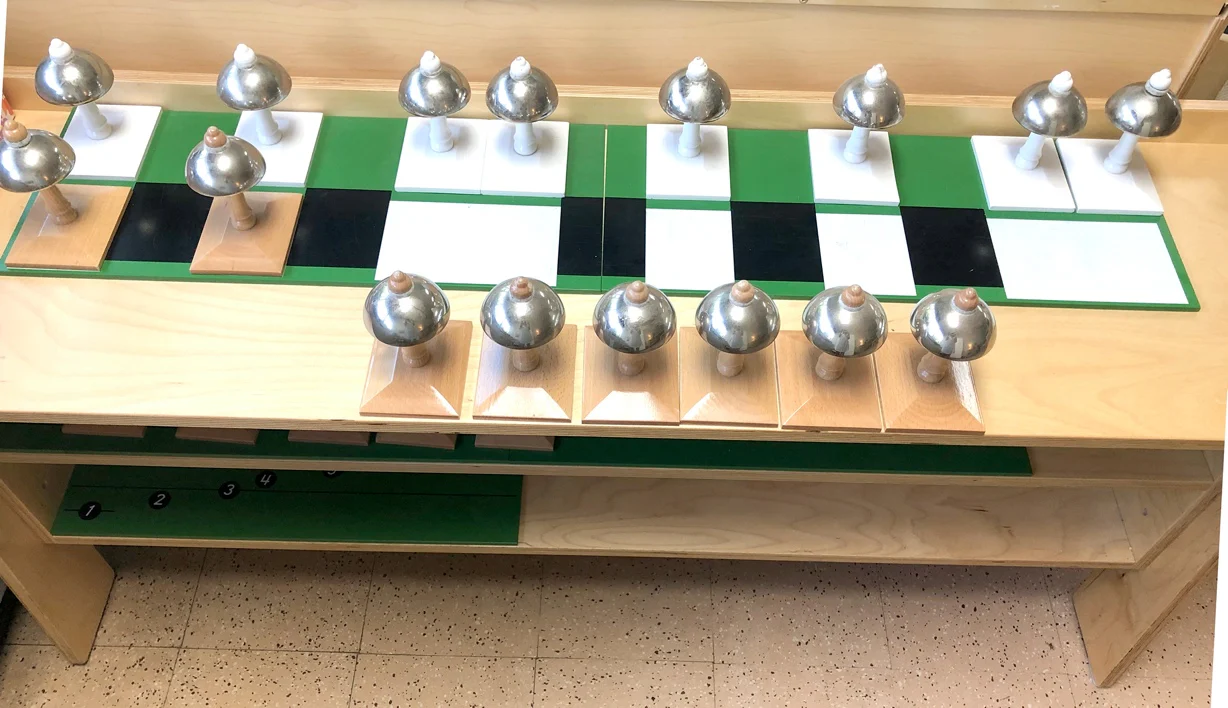The Montessori bells, or ‘sound bells,’ are a sensorial lesson designed for primary-level (3-6-year-old) children. Montessori bells help them understand auditory discrimination and recognise different sounds.
What are the Montessori Bells?
The Montessori Sound Bells are a crucial element of the Montessori sensorial curriculum. These bells are meticulously designed to aid children in developing auditory discrimination, which is the capability to recognise and differentiate between various sounds. The bells are set up on a chromatic scale, enabling children to explore and differentiate between various pitches and tones. This lesson aims to guide children in understanding pitch, tone, and musical notes through a hands-on, engaging activity. When children add sound bells to their learning routine, they can develop their overall sensory development and build a solid foundation for future musical education.
What do the Montessori Bells Look Like, and How Does It Work?
The Montessori Bells material comprises two sets: a control set and a working set, each containing 13 bells, totalling 26 bells. The bells range from middle C and ascend the chromatic scale for a full octave.
- The control set features bells with bases coloured black and white, resembling piano keys. The white bells represent natural notes, while the black bells signify sharp and flat notes.
- The working set includes bells with all wooden (brown) bases, mirroring the notes of the control set.
- A small wooden mallet, known as a striker, strikes the bells, and a cloth-covered dowel dampens the sound. These tools are typically stored in a small basket near the bells.
- The control set is arranged in order towards the back of the shelf, with the working set placed in order directly in front of it.
What is the Purpose of the Montessori Bells?
The Montessori Sound Bells serve a multitude of educational purposes, including:
- Auditory Discrimination: It helps children distinguish between different pitches and tones, which is a critical skill for language development and musical education.
- Musical Awareness: It introduces basic musical concepts and notes, fostering an early appreciation for music.
Concentration and Focus: It encourages careful listening and concentration, which are essential skills for academic success. - Fine Motor Skills: It develops coordination and precision in striking the bells, enhancing dexterity and hand-eye coordination.
By discriminating between sounds, a child can recognise the differences between phonetic sounds more easily.
Other Benefits of Montessori Sound Bells
The use of Montessori Sound Bells extends beyond mere auditory discrimination. Here are some additional benefits:
- Cognitive Development: Engaging with sound bells stimulates various areas of the brain responsible for processing sound, enhancing cognitive functions related to memory, attention, and auditory perception.
- Language Skills: By improving auditory discrimination, children can better distinguish between different sounds, aiding in language acquisition and phonemic awareness.
- Emotional Expression: Music and sound can be powerful tools for emotional expression. Sound bells allow children to explore and express their emotions in a creative and nonverbal way.
- Cultural Appreciation: Learning musical concepts at an early age can broaden a child’s understanding of musical traditions and cultures.
Montessori Bells Presentation
In this section, we will discuss the materials needed, control of error, points of interest and how to present the activity to the child.
Materials Needed
To conduct a lesson on Montessori Sound Bells, the following materials are required:
- A set of Montessori Sound Bells (typically consisting of two sets of bells, each set ranging from low to high pitch)
- A soft mallet or striker for striking the bells
- A control chart with the musical notes corresponding to each bell
- A mat or table to arrange the bells on
Control of error
- Control set
- Base stickers with the written note (optional)
Points of interest
- A wide range of tones
- Bells’ vibrations
How to Present Montessori Bells to the Child?
We have divided the presentation into 4 parts.
Initial Introduction:
- Invite the child to join the lesson with enthusiasm and curiosity.
- Show the child the set of sound bells arranged in order on a mat or table.
- Explain that each bell produces a unique sound, and today, you will explore these sounds together.
First Exploration:
- Take the first bell and gently strike it with the mallet, demonstrating how to listen carefully to the sound it produces.
- Encourage the child to take a turn striking the bell and listening attentively.
- Repeat this process with a few other bells, allowing the child to notice the differences in pitch between them.
Matching Sounds:
- Mix up the bells and invite the child to match the bells that produce the same pitch.
- Demonstrate the process by striking one bell and then searching for its matching sound.
- Allow the child to try matching the bells themselves, offering guidance and encouragement as needed.
Ordering by Pitch:
- Once the child is comfortable with matching sounds, ask them to arrange the bells in order from the lowest to the highest pitch.
- Provide support and allow the child to self-correct, promoting independent learning and problem-solving skills.
Montessori Bells Follow-Up Activities
To reinforce and expand upon the initial lesson, consider incorporating the following follow-up activities:
Sound Matching Games:
- Introduce games where the child matches the sound of a bell with a sound played from a musical instrument or a recording. This activity enhances their auditory discrimination and memory.
Musical Exploration:
- Encourage the child to explore creating simple melodies using the bells. This can be an exciting way to introduce elemental musical composition and creativity.
- Introduce basic musical notation and show how each bell corresponds to a musical note, laying the groundwork for future musical education.
Advanced Auditory Activities:
For older children or those who have mastered the basic exercises, introduce more complex auditory discrimination activities, such as identifying and replicating rhythms. This can further develop their musical skills and auditory acuity.
Practical Tips for Parents and Educators
To maximise the benefits of Montessori Sound Bells, consider the following practical tips:
- Consistent Practice: Regular practice with the sound bells can reinforce learning and help children internalise the concepts of pitch and tone.
- Positive Reinforcement: Encourage and praise the child’s efforts, focusing on their progress rather than perfection. Positive reinforcement builds confidence and motivation.
- Integrating with Other Activities: To create a holistic learning experience, integrate sound bell activities with other Montessori exercises, such as those involving movement, art, or language.
- Creating a Calm Environment: Ensure the learning environment is calm and free from distractions, which allows the child to focus entirely on the activity.
- Engaging Multiple Senses: While the primary focus is on auditory discrimination, engaging other senses, such as sight (visual cues) and touch (handling the bells), can enhance the learning experience.
Conclusion
The Montessori Bells are an excellent tool for developing auditory discrimination and musical awareness in children. By engaging with these bells, children learn to listen carefully, differentiate between sounds, and appreciate the beauty of music.
This lesson not only enhances their auditory skills but also nurtures their overall cognitive and sensory development.
By fostering a love for music and sound from an early age, we can help children develop skills that will benefit them throughout their lives, both academically and personally. The journey of learning with Montessori Sound Bells is one of discovery, joy, and endless possibilities.

